Gun Control & RKBA
Related: About this forum30 years of gun sales, or graphics showing gun control effort's unintended consequences
Last edited Mon Apr 5, 2021, 09:00 PM - Edit history (3)
A couple of months ago, when I had some free time, I dipped a toe into some of the BATFE's sales data on guns. Today, having lots of free time (avoiding the shopping frenzy and distracting myself from some personal issues) I went deeper into the ATF's data and crunched some numbers. I subtracted exports and added imports, and got a slightly newer version of the report (data goes to 2015, not 2013).
The sales numbers are from here:
Report database: https://www.atf.gov/resource-center/data-statistics
Direct link to the PDF: https://www.atf.gov/resource-center/docs/undefined/firearms-commerce-united-states-annual-statistical-update-2017/download
You can view my spreadsheet as either an Excel...
http://www.krispos42.com/Gungeon/ATF-gun-sales-1986-2015.xls
...or in the original OpenOffice Calc:
http://www.krispos42.com/Gungeon/ATF-gun-sales-1986-2015.ods
Note that I removed (and corrected for) the miscellaneous firearms category.
My original intent was to see how gun sales looked, corrected for population growth. The following charts are derived from that per-capita data. Feel free to save them, re-host them, or link to them.
First: here is the totals. This is sales per 1,000 people, with a trend line.
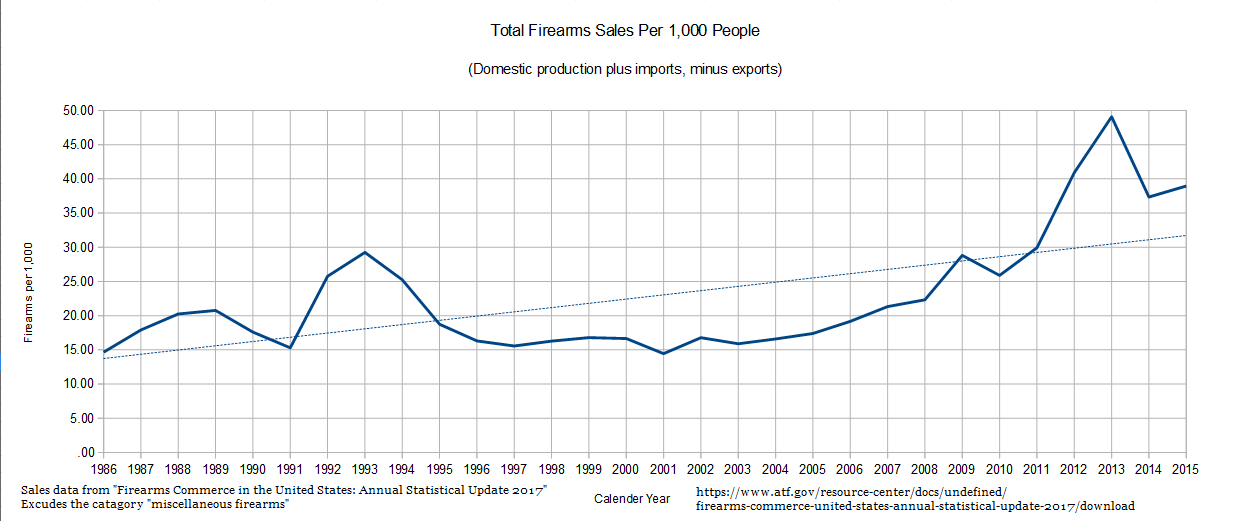
As you can see the exploding sales of handguns and rifles drive most of the increase; shotgun sales remain relatively flat.
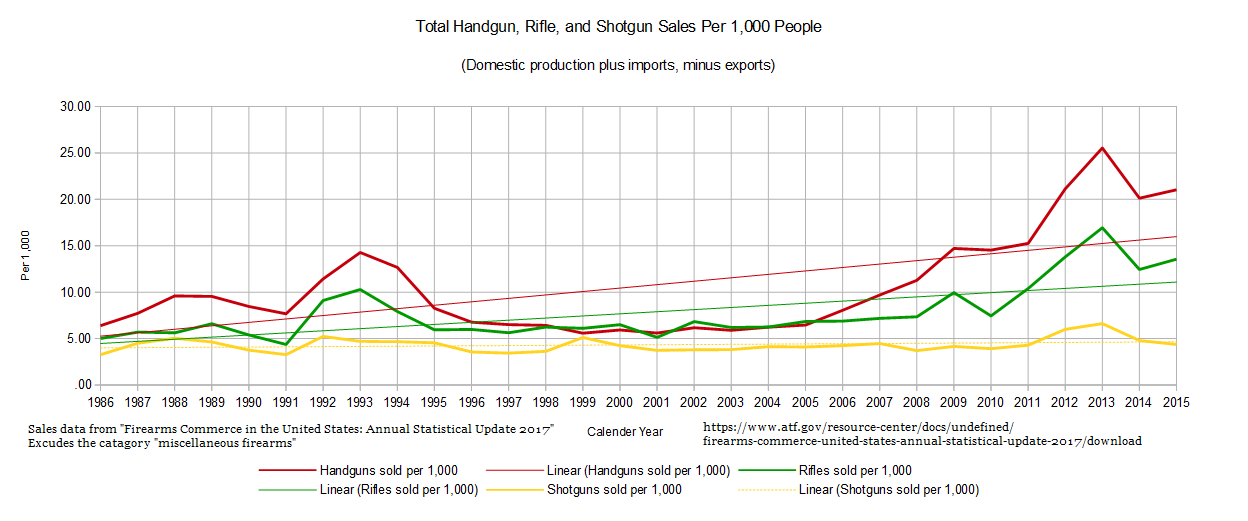
I'll let the reader speculate as to the rifle sales surge. Handgun sales are of course related to the liberalization of concealed-carry laws, as shown:
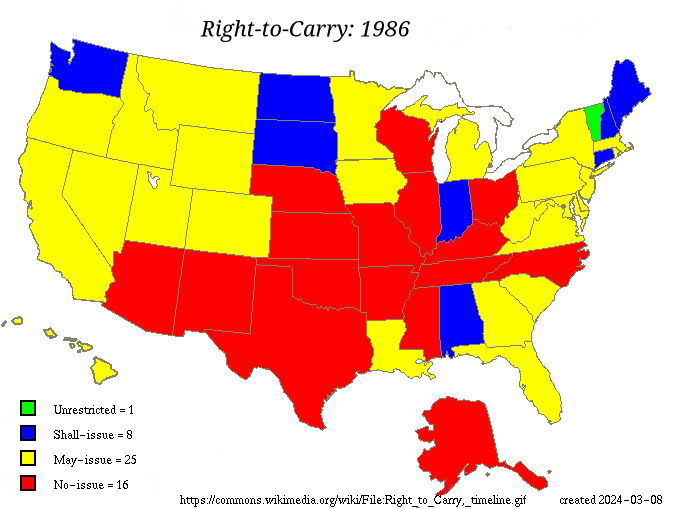
But what was really interesting was per capita sales relative to 1986. In other works, 1986 is "0" on this chart.
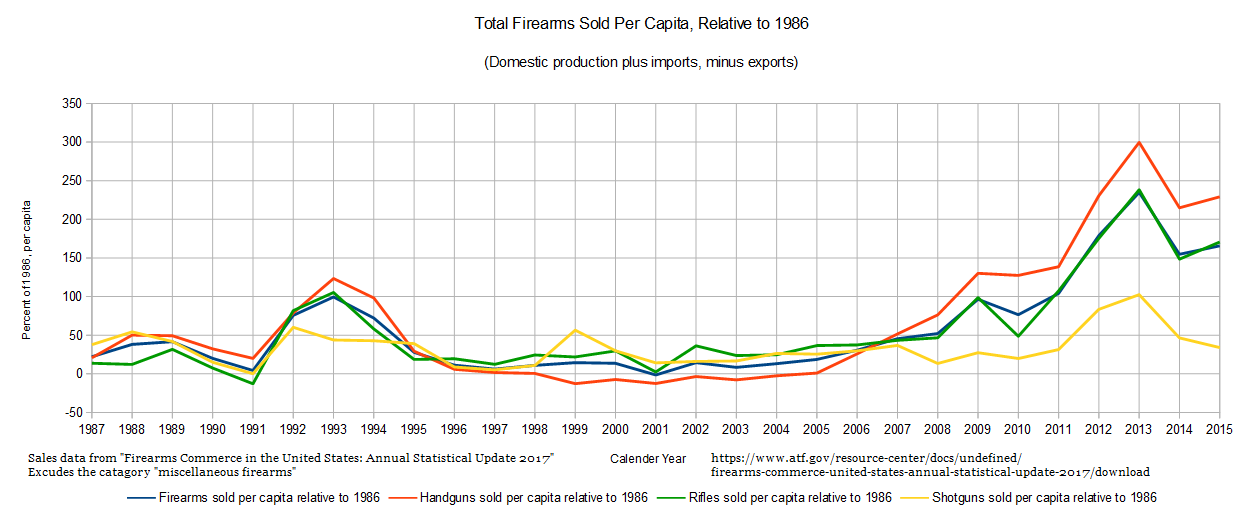
In 1986, 1,000 people purchased (on average) 14.66 guns. In 2015, those same 1,000 people bought 38.95! The peak was 2013, at 49.08. In fact, only one year (2001) has the number dip below 1986's rate, and only by 1.5% (14.45 guns per 1,000 people).
So, given the information presented, how can we judge the various efforts by various organizations on this issue? What is working, and what isn't? If the goal is X, is effort Y bringing us closer or further to X?
Here are stand-alone charts for handguns, rifles, and shotguns. I put them to the same scale for apples-to-apples visual comparison.
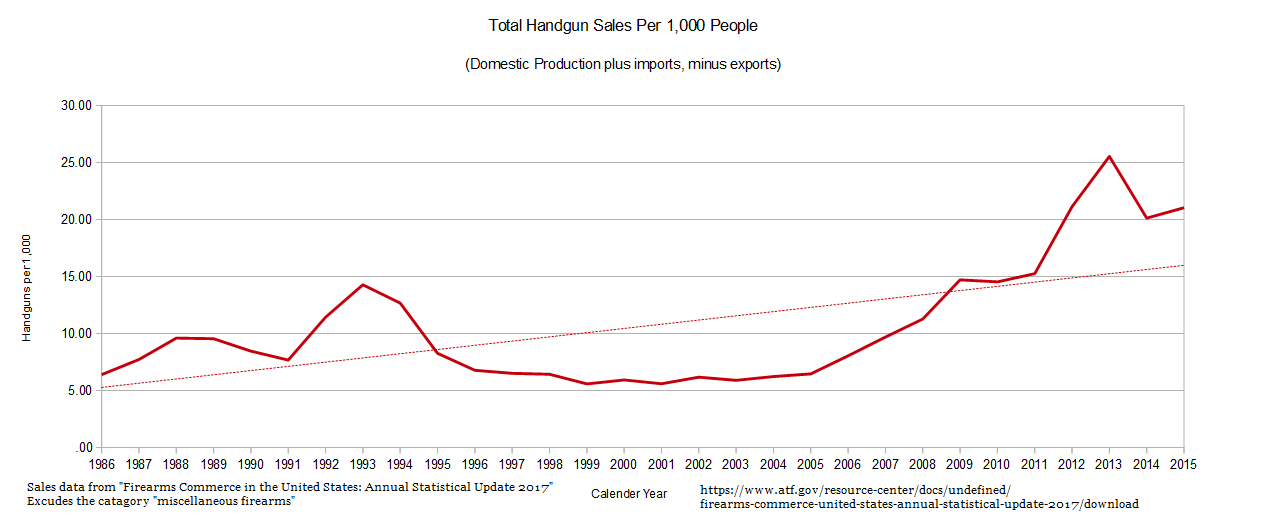
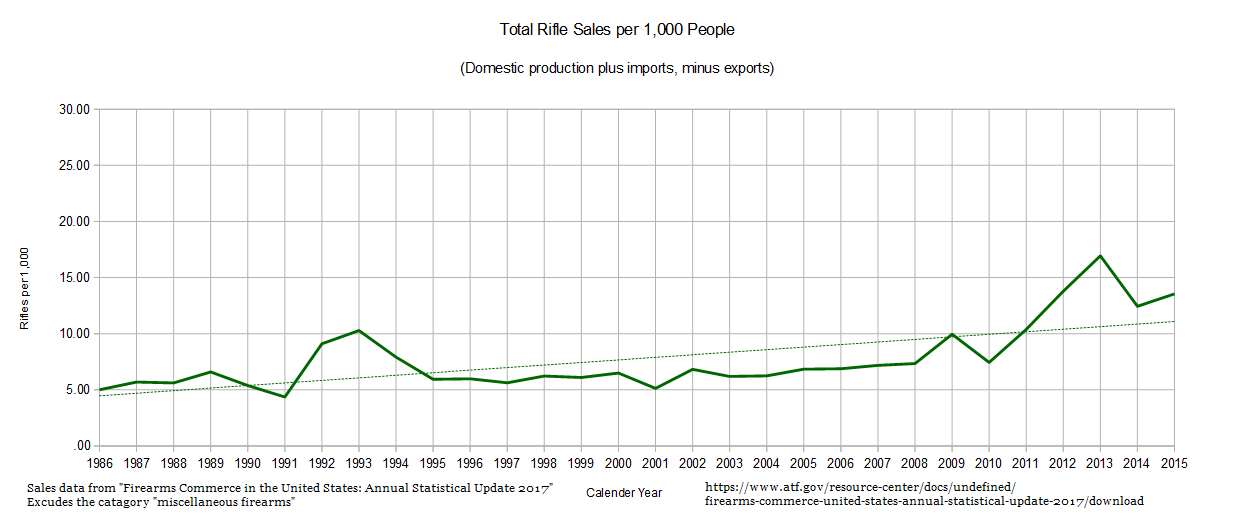
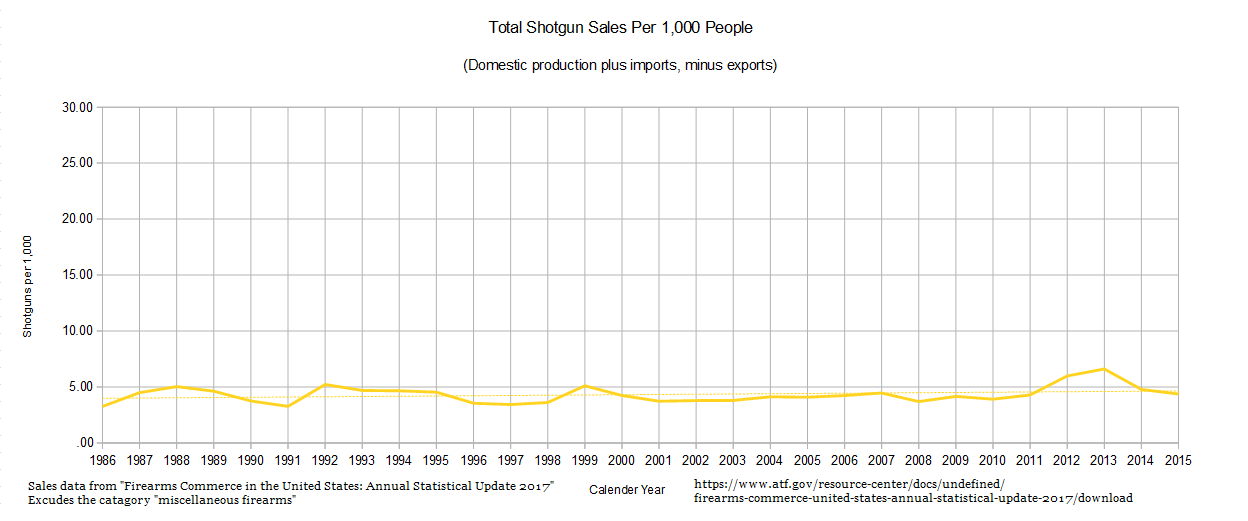
yagotme
(4,129 posts)MarvinGardens
(781 posts)I enjoy looking at and making these sorts of graphs too. Do the gun sales include those to govt / military, or are they only private sales? If it is only private sales, it could be argued that the early 90s AWB depressed handgun and rifle sales, but sales did not immediately uptick when the ban expired.
krispos42
(49,445 posts)So law enforcement and the like. FBI, State Department, state troopers, city cops, etc.
MarvinGardens
(781 posts)Paladin
(32,197 posts)After all the decades of pro-gun militants' efforts to render the agency inoperative, that's encouraging.
Alea
(706 posts)Most gun owners are just regular people from all walks of life and support the BATFE.
krispos42
(49,445 posts)So you can, for example, look up Remington and see how many guns they made in a given year.
Sales by companies specializing in the AR-15 style rifle would prove interesting.
jimmy the one
(2,776 posts)krispos: In 1986, 1,000 people purchased (on average) 14.66 guns. In 2015, those same 1,000 people bought 38.95! The peak was 2013, at 49.08.
Those 1,000 people also must've discovered the secret to longevity/ ponce de leon's fountain of youth.
Substantive new gun purchases, in recent years, have inordinately gone to existing gun owners, as the rate of gun ownership has fallen dramatically since the year 2000, accd'g to 4 reputable polls/surveys (GSS, Pew, Gallup (overall), and newbie CBS, jun 2016).
... the declining rates of gun ownership across three major national surveys suggests.. that most of the rise in gun purchases is driven by existing gun owners stocking up, rather than by people buying their first gun. A Washington Post analysis last year found that the average American gun owner now owns approximately eight firearms, double the number in the 1990s.
A 2004 survey found that the average gun owner owned 6.6 firearms, and that the top 3% of gun owners owned about 25 guns each. More recently, a CBS News poll {2016} found that roughly 1 in 5 gun owners owned 10 guns or more.
{CBS poll} June 15, 2016 ... conducted among 1,001 Americans in the aftermath of the Orlando nightclub shooting, 36% of U.S. adults either own a firearm personally, or live with someone who does = household gun ownership.... That's the lowest rate of gun ownership in the CBS poll going back to 1978. It's down 17 points from the highest recorded rate in 1994, and nearly 10 percentage points from 2012.
https://img.washingtonpost.com/wp-apps/imrs.php?src=
 &w=1484
&w=1484
https://www.washingtonpost.com/news/wonk/wp/2016/06/29/american-gun-ownership-is-now-at-a-30-year-low/?utm_term=.106f70c53303
Do you or does any other member of your household own a handgun, rifle, shot gun, or any other kind of firearm?
....... Total.. R .. Dem .. Ind
Yes, self ............... 13 20 9 12
Yes, other member.. 13 16 12 11
Yes, self and other.. 10 14 5 12
No .........................58 40 73 57
Don't know/No answer 6 10 2 https://www.cbsnews.com/news/orlando-nightclub-massacre-cbs-news-poll-assault-weapons-ban/
latest household gun ownership rate in the General Social Survey, in 2014, was 32% {corroborated by Pew}. The October 2015 Gallup survey showed a higher rate of 43%, including guns kept on property outside the home.
.. the downward trend in gun ownership remains consistent across the national polls. According to Gallup, gun ownership has fallen by about 10 percentage points since its peak in 1993. The General Social Survey shows a 20-point drop since the mid-1970s.
The 20/80 rule of thumb mentioned in title doesn't really apply to guns here, unless serendipitously or by chance; I just mentioned it as a, well, rule of thumb.
The Pew Research Center has tracked gun ownership since 1993, and our surveys largely confirm the General Social Survey trend. In our Dec 1993 survey, 45% reported having a gun in their household; in early 1994, the GSS found 44% saying they had a gun in their home. A Jan 2013 Pew Research Center survey found 33% saying they had a gun, rifle or pistol in their home, as did 34% in the 2012 wave of {GSS}.

https://www.democraticunderground.com/?com=view_post&forum=1172&pid=197829
spin
(17,493 posts)asked them if someone taking a survey appeared at their door or called them would they tell them they owned firearms. The overwhelming majority told me they never would.
What the surveys might be revealing is that fewer and fewer people are willing to admit they own a firearm to a stranger.
discntnt_irny_srcsm
(18,719 posts)...that their idea of privacy exists only between your ears. And then only if you're not a person of interest.
My phone asks me to share a picture or answer a question about the store I just left. Google tracks everything. I'm willing to bet that the NSA is in bed with Google.
With this level of intrusiveness I would be highly suspicious of any cold caller asking about damn near anything.
For all those folks that trust all the survey data, I have a nice bridge in Brooklyn they may be interested in buying. ![]()
![]()
spin
(17,493 posts)The NSA Hacked Google and Yahoo's Private Networks
More documents from the Edward Snowden leak show that the National Security Agency has tapped Google and Yahoo's cloud network.
PHILIP BUMP OCT 30, 2013
More documents from the Edward Snowden leak show that the National Security Agency has tapped Google and Yahoo's cloud networks to access massive amounts of data, including from Americans.
The report released Wednesday by The Washington Post indicates that the NSA has gained access to the fiber optic connections between the servers that power each company's network.
According to a top secret accounting dated Jan. 9, 2013, NSA’s acquisitions directorate sends millions of records every day from Yahoo and Google internal networks to data warehouses at the agency’s Fort Meade headquarters. In the preceding 30 days, the report said, field collectors had processed and sent back 181,280,466 new records — ranging from “metadata,” which would indicate who sent or received e-mails and when, to content such as text, audio and video.
***snip***
"Tapping the Google and Yahoo clouds," the Post writes, "allows the NSA to intercept communications in real time and to take 'a retrospective look at target activity,' according to one internal NSA document." By shunting millions of records to their Maryland servers each month, the NSA can more fully flesh out its social portraits of users. Included in that transmission of data is the activity of Americans, though it's not clear how and when that activity is stored.
https://www.theatlantic.com/politics/archive/2013/10/nsa-hacked-google-and-yahoos-private-networks/354570/
discntnt_irny_srcsm
(18,719 posts)....what everyone considers private information is OKAY because it's the government PROTECTING US. Daniel Webster has this to say about that:
From the NSA site:
So there it is. Anything they can't read is suspicious.
What have we learned? Power, money, position and influence allows laws to be meaningless for some. There is an investigation and clearance process called Yankee White. This process is required for some of the most sensitive and important jobs there are. The service person who carries briefcase known as the Nuclear Football undergoes this clearance process. However, there is now a person with clearance above that who shouldn't be there. This person has recent bankruptcies which would prevent their passing a Yankee White investigation (or likely any investigation for a clearance above standard Confidential) but because of money and influence...

spin
(17,493 posts)Some say that is an ancient Chinese curse.
discntnt_irny_srcsm
(18,719 posts)...I changed my sig line to add it there specifically to accompany the picture above it in post #13.
spin
(17,493 posts)undercover_redneck
(5 posts)Very informative. Thank you.